Engagement Ring Settings
Picking the right engagement ring style is as important as selecting the center stone — it can define the entire effect. When choosing a ring, consider look, budget, and the wearer's personality. All With Clarity styles are available in 14-karat or 18-karat white, yellow or rose gold, as well as platinum. Many styles can be made with nine different center diamonds. The more popular diamond shapes — such as round, princess and cushion — are available in the most setting styles, but even less common shapes like heart, pear and marquise come in a range of settings that can match any wearer's style.
Here's a quick guide to engagement ring setting styles. Ready to start shopping? Check out our full collection to see our nine popular diamond shapes.
TABLE OF CONTENTS
Stone Setting Styles
Diamonds and gemstone accents can be set in a variety of ways, each with a different look. When setting the ring, craftsmen can use one or combination of the following techniques. All have been refined over time to ensure they're secure.

Channel
Channel-set diamonds are suspended uniformly between two borders, creating the look of floating diamonds uninterrupted by metal prongs. This elegant look is used in many traditional engagement rings, particularly princess-cut and round accent diamonds.
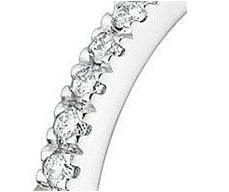
Micropave Set
In this style, accent diamonds are set closely together with small beads of metal holding them together. This draws attention to the diamonds and their sparkle, minimizing the look of the metal. Jewelers must work with high precision to set stones with this technique; lasers are often used to produce a flawless result.

Shared Prong
This style sets accent stones within a band in which each pair of stones are held by the same prong. Minimizing metal elements ensures that light hits the diamonds, enabling them to sparkle. It also creates a tighter, more uniform look.
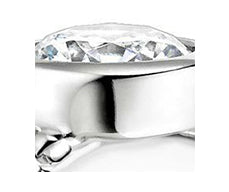
Bezel
This setting style encloses diamonds within a border, holding the stones securely in place and adding an attractive design element. Bezel-set rings are common for both men and women and have a classic appeal.
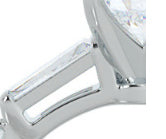
Bar
A bar setting holds diamond accents in place with bars of metal on either side. This secure setting style is typically used for baguette-style diamonds for three-stone ring styles or eternity bands.
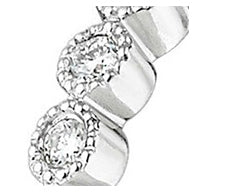
Flush
A flush-set diamond is enclosed completely by metal. The top of the stone is visible, with the rest is set within metal, creating a smooth surface. This setting style is used commonly within wedding bands and smaller accent diamonds. Flush settings are very secure, but because only the tops of the diamond or diamonds are visible, sparkle is somewhat lower than other setting styles.
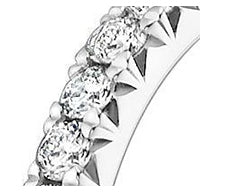
French Pave
This setting style is similar to the pavé setting, with a small, V-shaped cutout underneath each diamond adding another design element. This allows for more light to hit the diamond, as less metal shows on the ring.

Scalloped Pave
In this variation of the pavé setting style, the metal beads holding the accent diamonds have U-shaped cutouts underneath, reducing the look of metal. This pavé style is less common on engagement rings.
Setting Styles in Engagement Rings
So now you know about the different engagement ring styles — how do you choose?
Do you prefer the look of smaller accent diamonds with a minimal amount of metal? If so, consider the pavé styles. If you prefer a balance of metal and diamonds, a channel (or flush) setting will enable you to showcase the beauty of the diamonds in addition to metallic shine. If you prefer a subtle look in which the diamond is encased, a bezel setting is optimal.
Another important consideration is the thickness in millimeter of the band. Certain setting styles can be made with various band millimeter widths, while others require a thicker millimeter. Typically, bezel, flush and bar settings require more metal and slightly thicker bands. While band thickness is based on preference, the rule of thumb is that narrower fingers and smaller ring sizes look best when paired with thinner band widths. Larger fingers look better paired with slightly thicker bands, whether they're set with diamonds or not. Also consider which shape of accent diamond you'd like in your ring or band. Typically, baguette or longer diamonds are bar or bezel set. Micro-pavé, pavé, french pavé and scalloped pavé are set with round 14kt or 18kt white or yellow gold to platinum. Each metal type has its advantages, and the choice depends on your preference. Diamonds, especially, pair beautifully with all metals. Whether you have a question about gemstones, diamonds, or metals, our expert gemologists can help make your engagement ring buying process an absolute breeze.
FAQs
Can you change the setting on an engagement ring?
You cannot change the setting of a pre-set or an already crafted engagement ring. But you can use the customization/Create Your Diamond Ring option available at With Clarity to pick a setting of your choice. Some of the most popular options include solitaire, halo and three-stone.
How to wear an engagement and wedding ring set?
While the engagement ring and the wedding band are both worn on the left hand's ring finger, the wedding band goes on first, followed by the engagement ring on the top. While this is what tradition suggests, you can decide how and where you wear both rings.
What is a bridal set vs. an engagement ring?
A bridal set consists of the engagement ring and the matching wedding band for the bride. An engagement ring is given at the time of a proposal and is a single ring that can later be paired with a wedding band to create a stack.
At With Clarity, we offer matching wedding bands for every engagement ring on-site to make this process easy.
How long does it take to set an engagement ring?
At With Clarity, it takes us about 12 days to craft and deliver your engagement ring to your doorstep.









